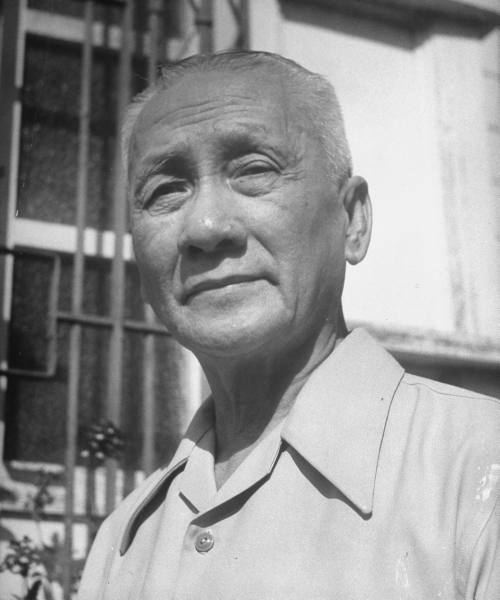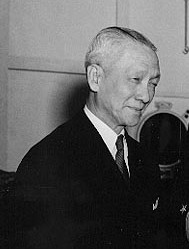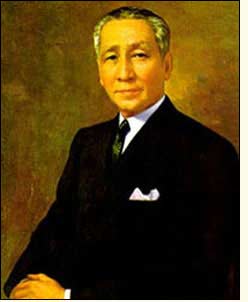<Back to Index>
- Physicist Luigi Galvani, 1737
- Writer Bharatendu Harishchandra, 1850
- 4th President of the Philippines Sergio Osmeña y Suico, 1878
PAGE SPONSOR


Sergio Osmeña y Suico (September 9, 1878 – October 19, 1961) was 4th and the second President of the Commonwealth of the Philippines. He was Vice President under Manuel L. Quezon, and rose to the presidency upon Quezon's death in 1944. He was a founder of Nacionalista Party.
Osmeña is the patriarch of the prominent Osmeña family, which includes his son (former Senator Sergio Osmeña, Jr.) and his grandsons (senators Sergio Osmeña III and John Henry Osmeña), ex-governor Lito Osmeña and Cebu City mayor Tomas Osmeña. Osmeña was born in Cebu to Juana Osmeña y Suico.
Juana was only 14 years old when she gave birth to him. Owing to the
circumstances of his birth, the identity of his father had been a
closely guarded family secret. Though an illegitimate child — Juana
never married his father — he didn't allow this aspect to affect his
standing in society. The Osmeñas, a rich and prominent clan of Chinese - mestizo heritage with
vast business interests in Cebu, slowly warmed up to him as he
established himself as a prominent figure in local society. He took his
elementary education in the University of San Carlos and graduated in 1892. Osmeña continued his education in Manila, studying in San Juan de Letran College where he first met Manuel L. Quezon, a classmate of his. He took up law at the University of Santo Tomas and was second place in the bar examination in 1903. Osmeña served on the war staff of General Emilio Aguinaldo as a courier and journalist. In 1900, he founded the Cebu newspaper, El Nuevo Día which lasted for three years. On
April 10, 1901, he married Estefania Chiong Veloso, with whom he had
eight children, namely, Vicente, Edilberto, Nicasio, Milagros, Emilio,
Teodoro, José, and Sergio, Jr. (former Senator). In 1920, two years after the death of his first wife, Osmeña married Esperanza Limjap, and had three more children, namely, Ramón, Rosalina, and Victor. In
1904, the American colonial administration appointed him governor of
Cebu. Two years later he was elected governor of Cebu. While governor,
he ran for election to the first Philippine Assembly of 1907 and was elected Speaker of that body. Osmeña was only 29 and already the highest ranking Filipino official. He and another provincial politician, Manuel L. Quezon of Tayabas, set up the Nacionalista Party as a foil to the Partido Federalista of Manila-based politicians. The two would engage in a rivalry for political dominance ever since.
Osmeña
was elected an assemblyman, in 1907, and remained a member of the lower
house until 1922. In 1922 he was elected to the senate. He went to the
US, in 1933, to secure passage of the Hare-Hawes-Cutting Independence Bill which was superseded by the Tydings-McDuffie Act in March 1934.
With
Quezon as president, Osmeña was elected vice-president; they
were inaugurated on November 15, 1935. Re-elected in 1941, he remained
vice president during the Japanese occupation when the government was
in exile. Osmeña agreed to the extension of Quezon's term for
the duration of the war, as provided for in a US congressional
resolution. Osmeña became president of the Commonwealth on Quezon's death in 1944. He returned to the Philippines the same year with General Douglas MacArthur and
the liberation forces. After the war, Osmeña restored the
Commonwealth government and the various executive departments. He
continued the fight for Philippine independence. For
the presidential election of 1946, Osmeña refused to campaign,
saying that the Filipino people knew of his record of 40 years of
honest and faithful service. Nevertheless, he won 54 percent of the
vote and became President of the independent Republic of the
Philippines.
On
August 8, 1944, President Osmeña issued Executive Order 15-W
reorganizing and consolidating the Executive Departments of the
Commonwealth government. The reorganization of the government after it
was reestablished on Philippine soil was undertaken with Executive
Order No. 27, February 27, 1945. Executive
Order No. 27, February 27, 1945 was issued upon the restoration of
civilian authority to the government of the Commonwealth, and members
of the new cabinet appointed on March 8, 1945. Subsequent renaming and
mergers of departments have separate listings.
Osmeña
accompanied U.S. General Douglas MacArthur during the landing of U.S.
forces in Leyte on 20 October 1944, starting the liberation of the
Philippines during the Second World War. Upon establishing the
beachhead, MacArthur immediately transferred authority to
Osmeña, the successor of Manuel Quezon, as Philippine
Commonwealth president. President Osmeña proceeded with the immediate reorganization of the government and its diverse dependencies. On
April 8, 1945, he formed his Cabinet, administering the oath of office
to its component members. Later, President Osmeña received the
Council of State to help him solve the major problems confronting the
nation. Government offices
and bureaus were gradually reestablished. A number of new ones were
created to meet needs then current. Also restored were the Supreme Court of the Philippines and the inferior courts. The Court of Appeals was
abolished and its appellate jurisdiction was transferred to the Supreme
Court, the members of which were increased to eleven - one Chief Justice and ten Associate Justices - in order to attend to the new responsibilities. Slowly
but steadily, as the liberating forces freed the other portions of the
country, provincial and municipal governments were established by the Commonwealth to take over from the military authorities.
On April 30, 1946, the United States Congress, at last approved the Bell Act,
which as early as January 20, had been reported to the Ways and Means
Committee of the lower house, having been already passed by the Senate.
President Osmeña and Resident Commissioner Ramulo had urged the
passage of this bill, with United States High Commissioner, Paul V. McNutt, exerting similar pressure. The Act gave the Philippines eight years of free trade with the United States, then twenty years during which tariffs would be upped gradually until they were in line with the rest of the American tariff policy. The law also fixed some quotas for certain products: sugar - 850,000 long tons; cordage - 6,000,000 pounds; coconut oil - 200,000 long tons; cigars - 200,000,000 pounds. The great aid this legislation meant for the Philippines was
coupled with that to be obtained from the recently passed Tydings
Damage bill, which provided some nine hundred million dollars for
payment of war damages, of which one million had been earmarked to
compensate for church losses. The sum of two hundred and forty million
dollars was to be periodically allocated by the United States President as a manifestation of good will to the Filipino people. Additionally, sixty million pieces of surplus property were also transferred to the Philippine Government. Soon after the reconstitution of the Commonwealth Government in 1945 Senators Manuel Roxas, Elpidio Quirino and
their allies called for the holding on an early national election to
choose the president and vice president of the Philippines and members
of the Congress. In December, 1945 the House Insular Affairs of the United States Congress approved
the joint resolution setting the election date at not later than April
30, 1946. Prompted by this congressional action, President Sergio
Osmeña called the Philippine Congress to
a three-day special session. Congress enacted Commonwealth Act No. 725,
setting the election on April 23, 1946, and was approved by President
Osmeña on January 5, 1946. Three parties presented their respective candidates for the different national elective positions. These were the Nacionalista Party - Conservative (Osmeña) Wing, the Liberal Wing of the Nacionalista Party, and the Partido Modernista. The Nacionalistas had Osmeña and Senator Eulogio Rodriguez as
their candidates for president and vice president, respectively. The
Modernistas chose Hilario Camino Moncado and Luis Salvador for the same
positions. On the other hand, the standard bearers of the Liberals were
Senators Manuel Roxas and Elpidio Quirino. On
January 3, 1946 President Osmeña announced his candidacy for
President. On January 22, 1946 Eulogio Rodriguez was nominated as
Osmeña's running mate for Vice President, in a convention held
at Ciro's Club in Manila. On January 19, 1946, Senator Roxas announced
his candidacy for President in a convention held in Santa Ana Cabaret in Manila. President
Osmeña tried to prevent the split in the Nacionalista Party by
offering Senator Roxas the position of Philippine Regent Commissioner
to the United States but the latter turned down the offer. As
a result of the split among the members of the Nacionalista Party,
owing to marked differences of opinion on certain vital issues of which
no settlement had been reached, a new political organization was born
and named the Liberal Wing of the Nacionalista Party, which would later become the Liberal Party. The election was generally peaceful and orderly except in some places where passions ran high, especially in the province of Pampanga. According to the controversial decision of the Electoral Tribunal of the House of Representatives on Meliton Soliman vs. Luis Taruc, Pampanga was under the terroristic clutches and control of the Hukbalahaps. So terrorized were the people of Arayat,
at one time, 200 persons abandoned their homes, their work, and their
food, all their belongings in a mass evacuation to the poblacion due to
fear and terror. A
total of 2,218,847 voters went to the polls to elect their President
and Vice President who was to be the Commonwealth's last and the
Republic's first. Four
days after election day, the Liberal party candidates were proclaimed
victors. Roxas registered an overwhelming majority of votes in 34
provinces and 9 cities. Likewise, the Liberal Party won nine out of 16 contested senatorial seats. In
the House of Representatives, the Liberals won an overwhelming majority
with 50 seats while the Nacionalistas and the Democratic Alliance only
got 33 and 6 seats, respectively. After
his defeat in the election, Osmeña retired to his home in Cebu.
He died of both liver failure and breast cancer at the age of 83 on
October 19, 1961 at the Veteran's Memorial Hospital in Quezon City. He is buried in the Manila North Cemetery in Manila.
